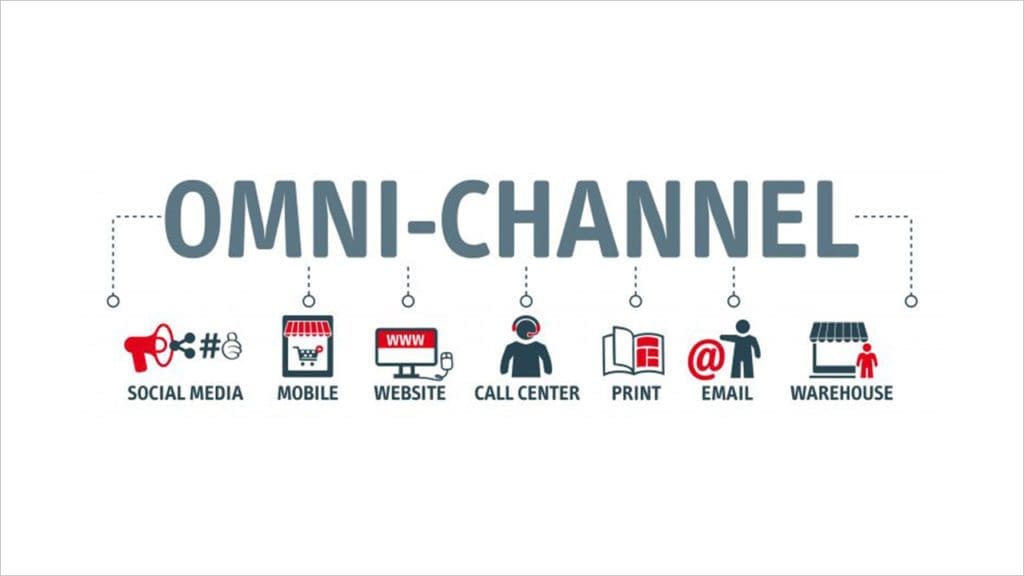Examples implemented by 7 amazing brands included below
In today’s fast-paced digital world, brands must think in terms of omni-channel marketing if they want to remain competitive. More and more companies are pushing for seamless experiences across all channels – from your website to physical store locations. This makes it essential for leaders to understand the multi-faceted nature of customer journeys. To help illustrate this point, I’ve rounded up 7 examples of brilliant omni-channel marketing efforts. These are from well known brands around the globe that are successfully executing a holistic approach to their marketing strategy. From experiential elements like augmented reality (AR) campaigns to single sign on solutions such as Facebook logins, learn how these businesses have seen success through robust cross channel initiatives.

Omnichannel marketing defined
Before we jump into the omni-channel examples, let’s define what omni-channel marketing is and why it’s important. Omni-channel marketing is a holistic approach to marketing that combines all channels of communication. Tactics such as email, mobile apps, social media, websites and more to create a unified customer experience. It’s about providing omni-channel customers with a seamless and consistent user experience no matter what device or channel they use.
Benefits of omnichannel marketing
Successful omni-channel marketing strategies can bring a number of benefits for brands. It allows companies to better understand customer behavior and preferences. This in turn enables them to create more personalized experiences that lead to increased loyalty and engagement from consumers. It can help brands improve their ROI by driving higher sales through more efficient channels. And also to use this data to inform their marketing efforts.
Omnichannel vs. multichannel vs. single-channel
Omni-channel, multichannel and single-channel are all terms used to describe various types of marketing strategies. Omni-channel marketing is a holistic approach that combines all channels to create a unified customer experience. Multichannel marketing uses multiple channels, but they may be disconnected from each other and not provide an integrated user experience. Single-channel focuses on one channel in order to reach customers.

Why is omnichannel experience design important?
Omni-channel experience design is the process of creating a comprehensive omni-channel strategy that can be customized to meet the needs and preferences of customers. It helps brands improve their customer service, increase their sales efficiency, better understand their audience and create more personal experiences for their customers. By having an omni-channel experience design in place, companies can ensure they are able to easily manage multiple channels. In turn, it will help deliver an exceptional and consistent user experience.
Developing an omnichannel marketing strategy
Developing an omni-channel marketing strategy starts with understanding your customers’ needs and preferences. It’s also integral to an integrative marketing approach. Make sure you have a good understanding of the customer journey, what channels they use and how they interact with each channel. Once you have identified the desired customer experience, it is important to consider the omni-channel opportunities available to you and develop a plan that will maximize them. This should include identifying key channels, creating omni-channel content, integrating data across all channels and creating personalized experiences for customers.
Omnichannel marketing strategy development checklist
I’ve compiled a checklist you can work through as you develop your omnichannel marketing strategies. Take a look and be sure to comment below if you have any questions.
1. Define your goals
Before you can develop an omnichannel marketing strategy, you need to know what your goals are. What are you trying to achieve with your marketing efforts? Do you want to increase brand awareness, drive more traffic to your website, or boost sales? Once you know your goals, you can start to develop a plan to achieve them.
2. Research your audience
It’s important that you understand who your target audience is before you start developing your omnichannel marketing strategy. What are their demographics? Interests? Motivations? The better you understand your audience, the easier it will be to develop a marketing strategy that resonates with them.
3. Identify your channels
An omni-channel marketing strategy uses multiple channels to reach consumers. This is important to identify which channels will work best for your business. Some common channels include social media, email, paid advertising, and organic search. Consider which channels will be most effective for reaching your target audience and achieving your goals.
4. Create compelling content
Once you’ve identified your channels, you need to start creating content that will resonate with your audience. Your content should be compelling and offer value if you want people to engage with it. If you’re not sure how to create compelling content, consider working with a copywriter or content strategist.
5. Develop an editorial calendar
To help keep your content strategy organized, it’s helpful to develop an editorial calendar. This calendar should include all of the content that you plan on creating. Also include when it will be published, and which channels it will be published on. Having an editorial calendar will help ensure that your content is consistent and timely.
6. Promote your content
Once you have created some great content, it’s time to start promoting it! Make sure that you are promoting your content on all of the appropriate channels (including social media, email, and paid advertising). You should also consider using influencers or paid sponsorships to help get your content in front of more people.
7. Analyze and optimize
After you have implemented your omnichannel marketing strategy, it’s important to analyze the results and make necessary adjustments. Which channels are performing well? Which ones aren’t? What type of content is resonating with your audience? Use this data to optimize your strategy and improve results over time.
Typical omnichannel marketing efforts and tactics
Typical marketing tactics used for omnichannel efforts include personalization, targeted messaging, omni-channel content creation and integration, cross-channel data analysis, and customer segmentation. By leveraging these tactics, businesses can create an omni-channel experience for their customers that is tailored to their unique needs and interests.
For example, a company might use omni-channel marketing to target customers with personalized messages across multiple channels such as emails, social media posts, text messages, ads etc. They could also track customer data across channels (e.g., website visits), analyze it to gain insights into customer behavior and then tailor their future campaigns accordingly. Furthermore, they could segment their customer base into different groups based on purchase history or other factors and send relevant messages to each group in order to drive conversions.
Many brands have seen success using omni-channel marketing tactics, such as Sephora and Amazon. Sephora uses omni-channel personalization to recommend products based on customer data collected across their website, mobile app, emails and other channels. Similarly, Amazon leverages omni-channel segmentation to send targeted messages to different customer groups via email, ads etc., in order to maximize conversions.
By leveraging omni-channel marketing efforts and tactics, businesses can create an effective marketing strategy that resonates with their customers and drives better results. It’s important to research your audience, identify your channels, create compelling content, develop an editorial calendar, promote your content effectively, and analyze and optimize your efforts to ensure success.

Increased customer engagement
When omni-channel marketing strategies are executed correctly, they can lead to increased customer engagement and satisfaction. This could include providing customers with a seamless experience as they move from one channel to another or offering personalized experiences based on their past interactions. With omni-channel solutions in place, brands can create more efficient sales processes, customer interactions, and increase conversions by providing customers with the same level of service across all channels.
These are all aspects to measure in your customer relationship management (CRM) system. By collecting and analyzing the data can only better your marketing campaigns, and omni-channel strategies to communicate through your marketing channels. This will help improve overall customer satisfaction whether they’re at a brick and mortar store or shopping online.
Consumers want unified, personalized experiences
More and more customers are expecting omni-channel experiences that are tailored to their individual needs. They want to be able to interact with a brand on any channel they choose, while having the same level of service and personalization no matter where they engage. By creating omni-channel marketing strategies that keep customer preferences in mind, brands can ensure they are providing their customers with consistent experiences that will keep them coming back for more.
A better view of the customer journey
Omni-channel marketing strategies can also help brands get a better view of the customer journey. By connecting customer data from different channels, companies can gain insights into their customers’ shopping habits and preferences. This information can be used to inform campaigns, improve customer service and create more personal experiences for customers.
Brand and customer loyalty
Omni-channel marketing can also help brands foster brand and customer loyalty. By providing customers with consistent omni-channel experiences, brands can create positive impressions and strengthen relationships with their customers. Customers are more likely to come back if they know the experience will be personalized and consistent regardless of the channel.
Realize increases in revenue
Omni-channel marketing strategies can help brands increase their revenue. By understanding customer behavior and providing omni-channel customers with a seamless, consistent user experience, companies can drive higher sales through more efficient channels and realize increases in revenue.
The examples of omni-channel efforts from well known brands around the globe show just how powerful omni-channel marketing can be. By taking a holistic approach to their strategies, brands can create unified experiences for customers and deliver personalized service that keeps them coming back for more. With omni-channel marketing, companies can increase their sales efficiency, gain better insights into customer behavior and realize increases in revenue. Ultimately omni-channel marketing can create a better customer experience and help brands stay competitive in today’s digital world.
Data-driven decision making
Finally, omni-channel marketing strategies can also help brands make more informed decisions when it comes to their campaigns. By having omni-channel data at their fingertips, companies can gain insights into customer behavior and use this information to refine their offering and ensure they are delivering the best possible customer experience.
7 Amazing brands and their omnichannel examples
Below I’ve listed some great examples of omni-channel success by some well-known brands:
Apple
Seamless experience across all channels to provide customers with an integrated experience
Apple puts a lot of effort into ensuring its customers have the best experience possible when interacting and engaging with it, whether it be through Apple products, on Apple websites or with Apple customer service. Apple is one of the few tech companies that strive to provide customers with an integrated, seamless experience across all channels. This continuously encourages people to come back and take advantage of Apple’s superior services and state-of-the-art technology day after day. Apple understands that customers want unrivaled convenience and satisfaction when engaging with them and they go above and beyond to ensure their users feel right at home!
Amazon
Effortless online-to-offline buying experience, allowing customers to make purchases from any device
Amazon has revolutionized the way we shop with its effortless online-to-offline buying experience. Shopping was never so convenient – Amazon makes it possible to purchase anything with a few clicks of the mouse or taps on the screen wherever and whenever you want. This added layer of ease gives Amazon customers the ultimate convenience when it comes to buying, no matter what device they choose. Amazon does not discriminate – desktop, laptop, tablet, or smartphone all work perfectly to engage in the Amazon shopping experience. From grocery items to tablets, Amazon promises a smooth transition from clicking “purchase” to receiving your goods.
Starbucks
Use of mobile technology and loyalty programs to create personalized experiences for their customers
Starbucks is at the forefront of innovation when it comes to providing unparalleled customer service. Their loyalty programs and mobile technology are key elements in creating a personalized experience for each Starbucks patron. Every time you order your favorite drink from the Starbucks app, or join a loyalty program, Starbucks is able to collect data about your preferences and habits, allowing them to quickly customize orders for their customers. From recommending products that fit a customer’s taste profile to providing rewards for having drinks purchased during peak times, Starbucks never fails to think outside of the box and constantly strive to provide your own convenient coffee experience.
Walmart
Integration of physical and digital stores, allowing shoppers to have a unified shopping experience
Walmart recently revolutionized the shopping experience by integrating physical and digital stores, giving shoppers a unified experience. Walmart’s model is simple yet effective: customers can now shop in store or online, and have their chosen items shipped directly to their door or to one of Walmart’s pickup points. Their approach makes shopping easier than ever for people who don’t have the time or energy for traditional shopping trips—or who simply want the convenience of buying something quickly from the comfort of their own home. Walmart’s digital integration is a game-changer for bargain-hunters and thrifty shoppers alike; with one visit, you can unlock Walmart’s full range of offerings and make sure you’re always getting top value for your money.
Nike
Partnerships with other retailers, such as Foot Locker, to offer more product availability across different channels
When Nike realized that expanding their product availability wasn’t just a nice idea but an imperative if they were going to remain competitive in the footwear industry, they decided to partner with Foot Locker and other retailers. This made sense since Nike was looking for greater reach and the multiple channels offered by Foot Locker allowed them to expand their pool of potential customers. Nike knew that taking part in collaborations with other retailers wasn’t only a way to offer more convenience to customers, but could also provide them with access to Nike products they’d otherwise not be able to get at a Nike store or website. All in all, it was a win-win situation for Nike and their customers alike!
Sephora
The ability to blend the online and offline shopping experiences into one cohesive customer journey
Sephora has always been a leader when it comes to enhancing the customer experience. From the in-store activities to the interactive online tools, Sephora continues to find innovative ways to exceed customer expectations. Sephora understands that today’s customers expect a seamless blend of an online and offline shopping experience and they have stepped up to create just that. They have embraced digital transformation and leveraged technology to bridge together one cohesive customer journey across all touch points. Sephora is setting the bar high for creating unique, customized experiences.
Burberry
Augmented Reality (AR) campaigns
Burberry has embraced omni-channel marketing by leveraging digital and physical experiences. The brand recently launched an AR campaign that allowed customers to virtually experience the products in their stores. Customers could scan the codes on Burberry’s products to get access to exclusive content, such as behind-the-scenes videos and product tutorials.
Omni-channel marketing is quickly becoming the norm for many brands as it allows them to provide an integrated, cross channel experience for their customers. These 7 examples of omni-channel efforts from well known brands around the globe are proof of how successful omni-channel strategies can be when done right. By understanding their customers’ needs and providing a seamless experience across different channels, brands can be successful in omni-channel marketing and remain competitive in today’s digital world.
Summary
The customer experience is increasingly becoming more integrated as companies take advantage of the many channels available. Today, we have seen how major companies like Apple, Amazon, Starbucks, Walmart, Nike and Sephora are utilizing technology to seamlessly combine their physical and digital channels for a unified customer buying experience. We hope this blog has inspired you to consider the possibilities open to your own business and how you can use all that technology can offer for creating a personalized buying journey. It doesn’t matter if you’re a small family-run shop or a giant corporation – always be ready to innovate.
Do any other brands stand out to you? What makes them exceptional? Comment below! Together, let’s explore the future of customer experience – in an integrated world.


